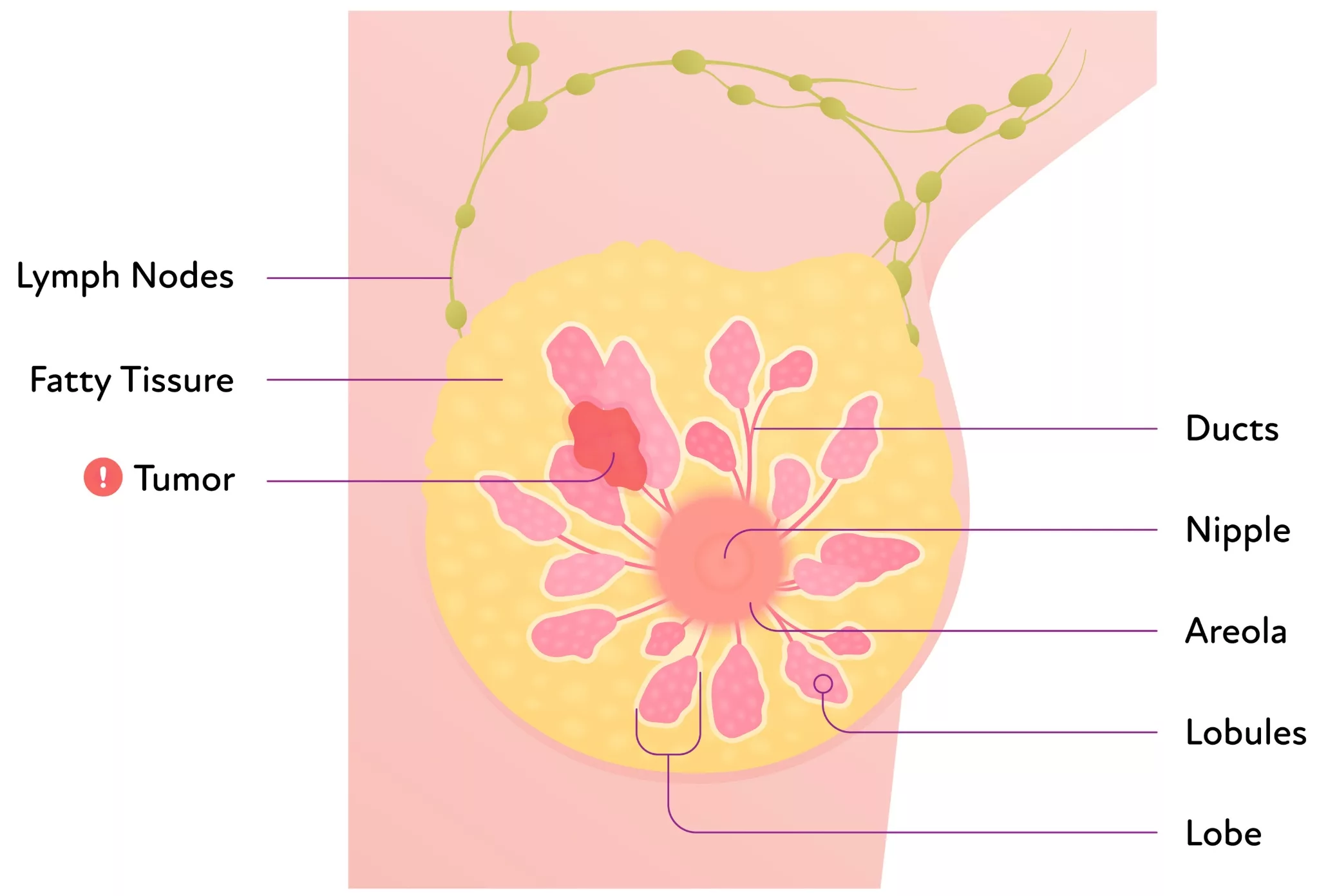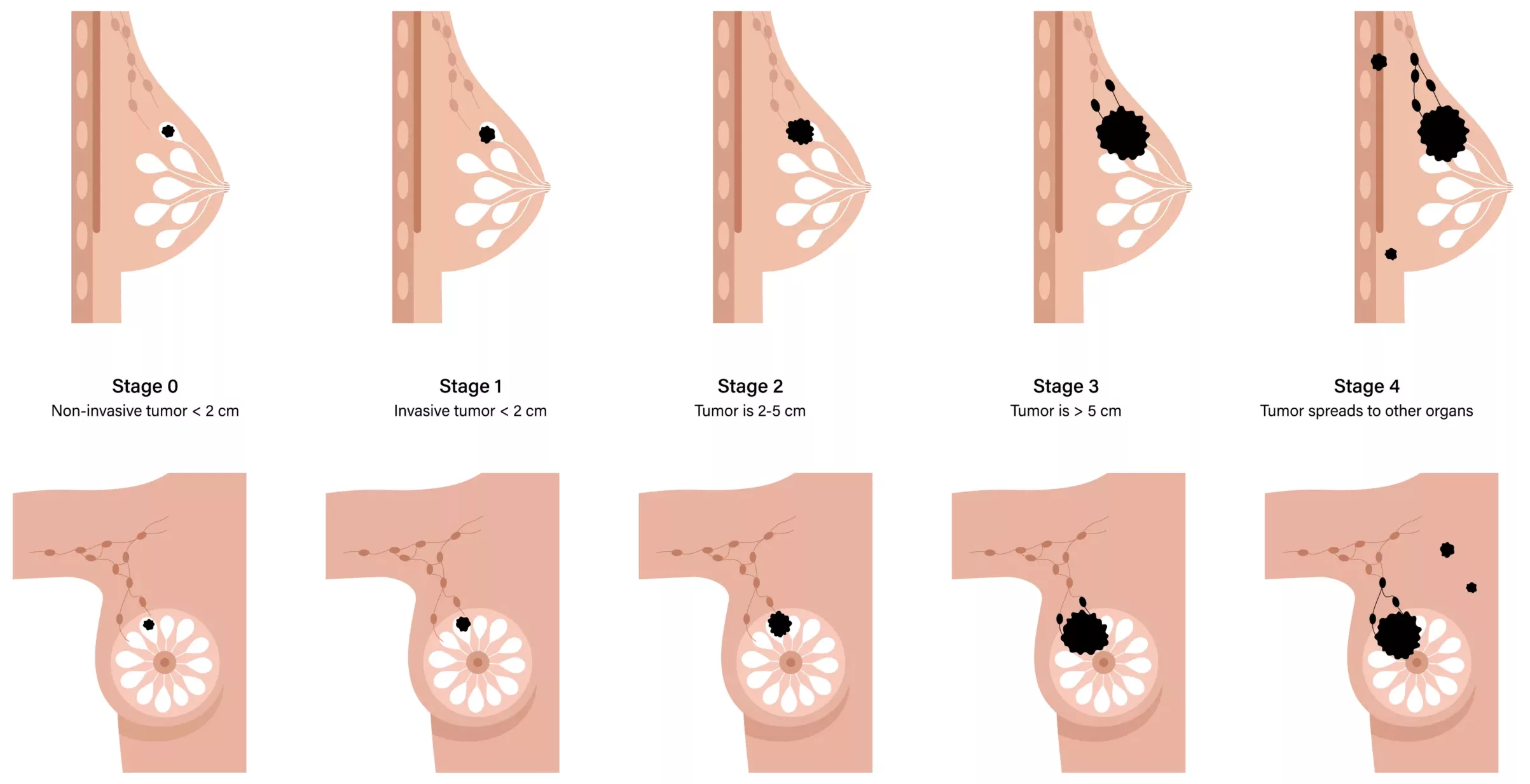Breast Cancer
Breast cancer occurs when cells in the breast grow uncontrollably, forming a tumor. Understanding the signs, types, and treatment options can lead to earlier detection and better outcomes.

Your Guide to Breast Cancer Care

Symptoms
- A lump or area of thickened tissue in the breast that feels different from the rest
- Changes in breast size, shape, or appearance
- Dimpling or puckering of the breast skin
- A nipple that turns inward (newly inverted)
- Peeling, scaling, or flaking of the skin around the nipple or on the breast
- Redness or pitting of the breast skin, resembling the texture of an orange
When to see a doctor
If you notice a lump or any change in your breast, even after a normal mammogram, schedule a visit with your doctor for a prompt evaluation.
Causes and Risk Factors
While breast cancer often begins in the milk ducts (invasive ductal carcinoma) or lobules (invasive lobular carcinoma), it can also form in other breast tissues. In some cases, these cancerous cells may spread to nearby lymph nodes or other parts of the body.
The exact cause isn’t fully understood, but several factors may increase risk:
- Genetic mutations, such as BRCA1 and BRCA2
- Family history of breast or ovarian cancer
- Hormonal factors, including long-term hormone therapy, early menstruation, or late menopause
- Age, with risk increasing as you get older
- Lifestyle choices, like obesity, lack of physical activity, smoking, and alcohol use
Even with known risk factors, some people never develop breast cancer, while others do without any clear cause. It’s likely the result of a complex interaction between genetics and environment.
Prevention
You can help reduce your risk of breast cancer with these preventive steps:
- Schedule regular screenings and mammograms
- Maintain a healthy weight and balanced diet
- Limit alcohol intake
- Stay physically active
- Avoid smoking
Diagnosing Breast Cancer
To diagnose breast cancer, your doctor may use several tests to confirm the presence of cancer, determine its type, and guide treatment. Depending on your situation, additional tests may be recommended to gather more information.
Breast Exam: Your doctor will check both breasts and nearby lymph nodes for lumps or other abnormalities.
Mammogram: This X-ray of the breast is a common screening tool. If something unusual shows up, a diagnostic mammogram may be used to get a closer look.
Breast Ultrasound: Ultrasound uses sound waves to distinguish between solid masses and fluid-filled cysts.
Biopsy: This is the only way to confirm a breast cancer diagnosis. A small sample of tissue is removed (usually with a needle guided by imaging) and sent to a lab. The biopsy reveals whether the cells are cancerous, what type they are, how aggressive the cancer is (its grade), and whether it has hormone or other receptors that may affect treatment.
Breast MRI: MRI uses magnets and radio waves, not radiation, to create detailed images. A contrast dye is injected beforehand to enhance image clarity.
Understanding Breast Cancer Stages
After diagnosis, your doctor will determine the stage of your breast cancer and how far it has grown or spread. Staging, from 0 to 4, guides treatment and is based on tumor size, lymph node involvement, and whether the cancer has spread.
Stage 0 (In Situ)
- Non-invasive cancer (often DCIS)
- Abnormal cells are found only in the ducts or lobules and haven’t spread
- Typically highly treatable and caught through routine screening
Stage 1 (Early Stage Invasive)
- Tumor is under 2 cm and may or may not have reached nearby lymph nodes
- Cancer has started to invade surrounding tissue but is still localized
- High chance of successful treatment
Stage 2 (Localized Invasive)
- Tumor is 2–5 cm and may have spread to a few nearby lymph nodes
- Still considered treatable, but may require a combination of therapies
Stage 3 (Locally Advanced)
- Tumor is larger than 5 cm or has spread to multiple lymph nodes or surrounding breast/chest wall tissue
- More aggressive treatment often needed, including chemo, surgery, and/or radiation
Stage 4 (Metastatic)
- Cancer has spread beyond the breast and lymph nodes to other organs (bones, lungs, liver, brain, etc.)
- Treatment focuses on managing the disease and improving quality of life
Breast Cancer Stages

Treatment
Each breast cancer treatment plan is tailored to individual needs, based on the cancer’s type, stage, grade, size, and hormone sensitivity. We understand that navigating treatment options can be overwhelming, which is why our team is committed to providing clear guidance, compassionate care, and unwavering support throughout the journey.
Care plans may include*:
Breast cancer surgery
- Lumpectomy: removes only the tumor
- Mastectomy: removes one or both breasts
- Sentinel lymph node biopsy: removes a limited number of lymph nodes
- Axillary lymph node dissection: removes several lymph nodes
Therapies
- Radiation therapy
- Chemotherapy
- Hormone therapy
- Targeted therapy drugs
- Immunotherapy
Supportive / Palliative care
*This is not a comprehensive list, and availability may vary by provider.
Types of Breast Cancer
Breast cancer can be classified into several types based on where it starts and how it behaves. Here are some of the main types:
Ductal Carcinoma In Situ (DCIS)
A non-invasive cancer where abnormal cells are found in the lining of a breast duct but haven’t spread outside the duct.
Invasive Ductal Carcinoma (IDC)
The most common type, starting in the milk ducts and then invading nearby tissue.
Invasive Lobular Carcinoma (ILC)
Begins in the milk-producing lobules and can spread to other parts of the body.
Special Types of Invasive Breast Cancer
Triple-Negative Breast Cancer
Lacks estrogen, progesterone receptors, and excess HER2 protein, making it more challenging to treat.
Inflammatory Breast Cancer
A rare and aggressive form where cancer cells block lymph vessels in the skin, causing the breast to appear red and swollen.
Less Common Types
Paget Disease of the Breast
Starts in the ducts and spreads to the nipple and areola.
Angiosarcoma
A rare cancer that starts in the blood vessels or lymph vessels of the breast.
Hormone Receptor Status
Breast cancers are also classified based on hormone receptor status:
Hormone Receptor-Positive
Cancers that have receptors for estrogen (ER) or progesterone (PR), which can influence treatment options2.
HER2-Positive
Cancers that produce excess HER2 protein, which can be targeted with specific therapies2.
From Diagnosis Through Survivorship
At Lowcountry Oncology Associates, we’re committed to delivering expert, compassionate care tailored to individual patient needs. Our team works together to provide high-quality, cost-effective treatment with timely access to the specialists and services that matter most, from diagnosis through survivorship.

